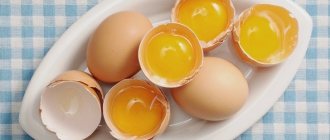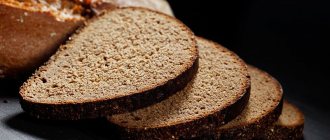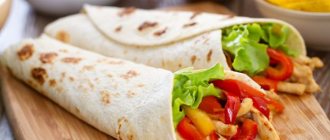January 27, 2021
Acne is an inflammatory disease of the skin, which is caused by changes in the sebaceous glands, as well as their excretory ducts and hair follicles. The causes of acne include heredity, hormonal imbalances, stress, gynecological diseases, taking certain medications, poor environment and unbalanced diet. To normalize sebum production, a diet is prescribed as a comprehensive component of treatment.
Myths and reality: how flour affects your figure

“Flour is bad for your figure,” we hear on every corner and still continue to eat it. Let's figure out once and for all whether this is really so.
What products are considered flour
Flour is anything made from flour:
- Confectionery products - all kinds of pastries, cakes, made from premium flour, with the addition of fats and sugar.
- Culinary products - semi-finished products such as dumplings and pasties, pasta, also consisting of white flour, but without sugar and fat.
Which of these is safe for your figure? Let's figure it out.
When we say “flour”, we mean premium white wheat flour. Bread has become an almost universal component of diets around the world. And even at the base of the pyramid of proper nutrition, up to 50% consists of cereals and grains.
During the year, the average Russian eats about 130 kilograms of bread. This is fifty kilograms more than the Germans eat, and sixty more than the Italians. According to statistics, we get up to 1/2 of all calories consumed from bread.
“But our ancestors ate flour for many centuries and did not suffer from it!” - you may object. So it is, only the difference in wheat 50 years ago and wheat now is colossal. Genetic modifications of wheat have led to increased yields and resistance to pests and frost. And at the same time they changed the composition of the grain. Even the wheat looks different now: low-growing, with grains, practically without husks.
Modern wheat contains huge amounts of amylopectin-A , which helps increase blood sugar levels. This explains why wheat increases blood sugar levels much more than legumes or potato chips.
Amylopectin-A, found in wheat foods, can easily be called a “supercarbohydrate”. Even wheat-based complex carbohydrates, when consumed regularly, can be worse than simple carbohydrates such as sucrose.
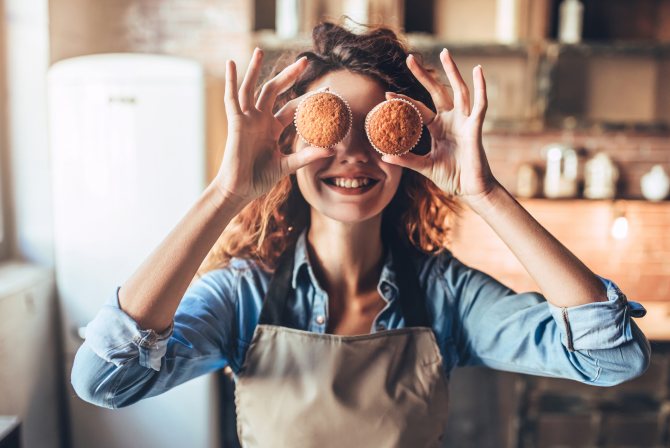
photo: Vasyl Dolmatov / iStock / Getty Images
It's all about the glycemic index of foods
In 1981, at the University of Toronto, the concept of glycemic index (GI) was introduced - an indicator characterizing a particular product by the increase in blood sugar levels after its consumption. In other words, GI reflects the rate of breakdown and conversion of a particular product into glucose. The more the blood sugar level increases compared to pure glucose, the higher the glycemic index of the product. It was found that the GI of white bread is 69, and that of whole grain bread is 42.
However, GI is an indicator that is not an axiom. Later, another, more objective indicator was introduced to determine the effect of a particular carbohydrate on the body, namely the glycemic load (GL). The GL helps predict how much a food will raise your blood sugar and how long it will remain high. If GI helps to assess the quality of carbohydrates, then GL speaks of their quantity.
Glycemic load is calculated using the formula:
GL = (GI × Carbohydrates in grams) / 100.
Gradation of glycemic load (GL):
- low to 10;
- average 11–19;
- high 20 and above.
The amount of daily GL should not exceed 100; for those losing weight, it is better to reduce this figure to 60–80.
Tricks that can lower or increase the glycemic index of foods:
- Industrial processing of grain leads to an increase in its GI. For example, corn on the cob has a GI of 70, corn flakes already have a GI of 85.
- Cooking leads to the digestion of starches and increases the GI.
- Pastification reduces the glycemic index. When making pasta, they are passed through a die (holes in the mold). Heating occurs and a natural film forms. It does not allow starches to quickly gelatinize. Al dente pasta - GI 35.
- The more thoroughly the product is crushed, the higher its GI. Therefore, all products made from premium flour have a GI of 70-95. But whole grain bread - 35.
Life hack: adding protein to carbohydrates can reduce their negative impact in the form of a sharp increase in blood sugar levels. If you want something sweet, add protein.

photo: Petar Chernaev / E+ / Getty Images
What is gluten and what you need to know about it
Wheat is also the main source of gluten in the human diet. Now everyone is obsessed with his intolerance. There are gluten-free products with inflated price tags. What to do with him?
If you add water to wheat flour, knead the dough, and then rinse the ball under running water to remove starch and fiber, you will get pure gluten . Gluten gives dough its characteristic properties: it rolls and molds well. Gluten causes the dough to rise and the yeast fermentation creates tiny air pockets.
In celiac (an intestinal disease), gluten proteins, primarily alpha-gliadin, trigger an immune reaction that leads to inflammation of the small intestine, causing stomach cramps and diarrhea. This is a severe genetically determined autoimmune disease that, fortunately, occurs in no more than 1% of humanity. There can be only one treatment in this situation: complete abstinence from any products containing gluten.
Gluten is found in oatmeal, barley, rye, semolina, and triticale (a special hybrid of rye and wheat, common in the USA). And this is almost our entire diet: bread, pastries, pasta made from wheat flour, bulgur and couscous, soy products, sausages, semi-finished products, sauces, canned food, fast food, sweet syrups, ice cream, alcoholic beverages.
How does a gluten allergy manifest?
- bloating;
- nausea;
- loose stools;
- skin manifestations in the form of a rash;
- increased body temperature;
- weakness;
- fatigue;
- anxiety;
- migraine;
- labored breathing.
Insufficient absorption of nutrients - gluten is also to blame. Once in the intestines, it not only irritates its walls, but also prevents vitamins and other beneficial substances from being absorbed normally. As a result, we overeat and can’t get enough of food. In this case, eliminating foods containing gluten in combination with intestinal detox programs will help restore normal digestibility of food.
Eat delicious and healthy gluten-free grains: buckwheat (regular and green), millet, amaranth, rice, corn, quinoa.
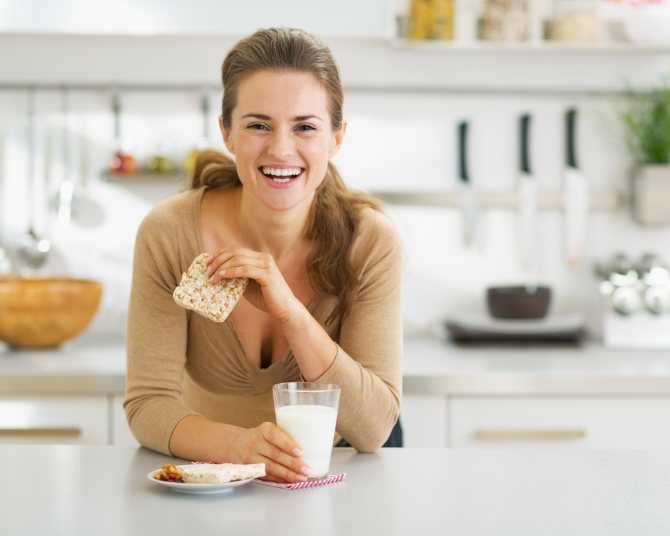
photo: CentralITAlliance/iStock/Getty Images
Basic questions about losing weight when eating flour products:
1. Will I lose weight if I eat gluten-free baked goods?
No! Regardless of the presence or absence of gluten, a cake is still a cake.
2. Are any baked goods harmful?
Not just any one. If you bake your own with healthy low GI flour and no sugar, this is the best thing you can do. Look at what healthy flour there is and what its GI is. Of course, such baked goods are unsweetened and will not rise, but they will be healthy.
3. Is rice flour healthier? Many PP recipes are based on rice flour.
The GI of rice flour is almost equal to wheat flour. This means that it will also sharply increase blood glucose. Any nut or coconut flour is much healthier. Try to eat foods with a GI of less than 70.
4. Is it possible to have cheat meals sometimes?
Of course you can. Only in moderation. Without feeling guilty that you do it. For example, if you want to try dessert, try it and savor it. You don't have to eat it whole. You can satisfy your taste buds with a small piece, eaten slowly. You won't even want to finish it. You will be satisfied with the taste.
5. What kind of bread is better to buy?
I recommend learning how to bake bread yourself, for example, from green buckwheat, or buying from trusted suppliers. Let it be bread made from whole grain flour, wholemeal flour, with cereals. A piece in the morning with protein - for example, breast or cheese - will give long-term satiety and a lot of vitamins. This would be the perfect breakfast if you add a couple of lettuce leaves and a cucumber. In the evening we no longer eat bread, or indeed any carbohydrates. All carbohydrates must be eaten before lunch.
6. Is it possible to eat crispbread instead of bread?
Look at the composition. They usually contain a lot of salt, flavor enhancers and other harmful ingredients. Take only whole grain breads. But without additives they will not be tasty, and therefore they are practically impossible to find. It's better to do it yourself.
7. Will expensive bread from good bakeries fill me up?
It all depends on the quality and composition, and not on the price. And also on quantity. No more than 50 grams of whole grain bread without trans fats and sugar per day will help you maintain your figure and health. It will not make you fat if you know when to stop and consume it on time (before lunch).
8. Why can’t you give up baking forever?
Baked goods contain sugar and fats, which in combination act like a drug. Their combination reduces pain and stress. For many, baking is the most accessible source of positive emotions. Learn to enjoy others. Find your source of pleasure other than food.

photo: Prostock-Studio / iStock / Getty Images
conclusions
- If you choose the right composition of grain products and consume them in moderation, you will only benefit.
- By consuming too much bread, we reduce the proportion of healthy vegetables in our diet. Shift your emphasis towards vegetables, and the result will not keep you waiting long.
- Only flour made from refined white flour is harmful. Use flour from non-starchy plants - chickpeas, peas, coconut. Any flour with a glycemic index of up to 40-50 will do.
- Remember: excess body weight is affected not only by what and in what quantities you eat, but by how you spend the energy you receive.
The fat on your sides is not an overdose of fat in your food! This is an overdose of carbohydrates in your diet!
Bread for weight loss: can you eat it and what can you replace it with?
What kind of bread can you eat while losing weight? Expert advice
Since childhood, most of us have become accustomed to the constant presence of fresh bread on the dining table. It was and is eaten separately from other food, as a base for sandwiches, or as a snack to a bowl of soup. It seems completely impossible to imagine that this product could be harmful or dangerous. And from school times, from children's books, we remember about bread almost as the basis of the diet since ancient times. Is it really? What is a product called “bread” in today's reality? Is it possible and necessary to eat it, and, if so, when, what kind and in what quantities? Is it combined in the diet with the desire to lose weight or the use of a particular diet? We will try to answer these questions for you in this material.
What bread is good for weight loss?
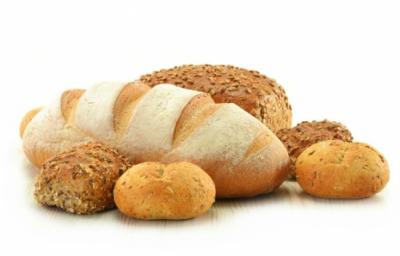
It may not be strange, but bread made from premium wheat flour has a minimum of benefits. It has an increased shelf life and is not susceptible to pests; however, during the multi-stage cleaning and processing procedure, this product almost completely lost its positive properties. Moreover, it no longer contains any microelements that our body needs. But, what is much worse, there is danger in it. First of all, this concerns a large amount of simple carbohydrates, which have a detrimental effect on your figure. Secondly, the technological features of its baking give rise to compounds (including carcinogenic ones) that can provoke various diseases, including cancer.
Therefore, if you are used to eating bread and are not ready to exclude it from your diet at the moment, you should choose those varieties that are made from whole grain wholemeal flour. In addition, you should not get carried away with eating loaves and baguettes just like that, as a snack. It can be the basis for a light sandwich or an addition to a vegetable salad. Another good option is to use croutons as an addition to first courses.
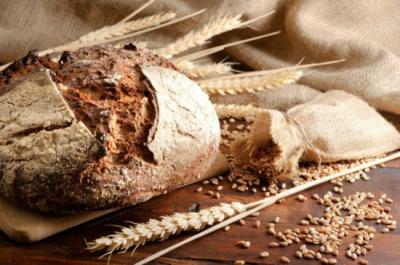
A tasty and healthy bread for weight loss is the so-called “black” bread, which is based on barley or rye flour. This product is rich in vitamins and amino acids, and also retains many microelements important for the body. At the same time, it meets two main requirements - it does not harm health and at the same time prevents weight gain. At the same time, we must remember that moderation is necessary in everything. Knowing the calorie content per 100 grams of a product, it is easy to determine the maximum daily intake and strictly follow it. This point should be especially taken into account by those people who prefer “Borodinsky” bread - it is somewhat higher in calories. But bread with bran boasts the lowest level of this indicator, while it provides quick satiety and speeds up metabolism.
Good rye bread helps to improve the functioning of the gastrointestinal tract (both in terms of normalizing its work and in terms of cleansing), which is acceptable for inclusion in the menu of people suffering from diabetes.
How to replace bread when losing weight?
If you are ready for radical changes in your habits, and strive to switch to a healthy diet as soon as possible, get ready to give up bread in your diet. It can be replaced gradually. At the initial stage, reduce portion sizes and use the product only as an ingredient for sandwiches (with lean chicken or fish).
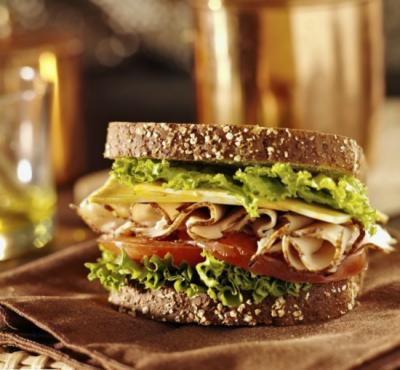
Make sure the pieces are thin. Gradually switch to cereals and legumes, and use bread for toast. However, be careful with the latter: pay attention to the method of their preparation (baked ones are not suitable), as well as to the composition - nothing foreign is allowed in it. First of all, this concerns yeast. Don't forget about this type of bakery product, such as sheet pita bread - prepared on the basis of a classic recipe, it consists of only three components - yeast-free flour, water and salt. At the same time, given that wheat flour is used in this case, you shouldn’t get too carried away with it either. But the benefits of lavash in comparison with the traditional loaf are undeniable and obvious.
Get ready to exclude sandwiches from your daily breakfasts and snacks (at least in their usual form). Introduce fermented milk products into your diet (low-fat cottage cheese, natural yoghurts without additives), a variety of cereals (classic oatmeal, including with milk), add variety with fruits and berries.
Whatever decision you personally come to after reading this article, let us conclude by saying the following: not even the strictest diet will bring any results; moreover, it will lead to stress and nervous breakdowns, as well as a general deterioration in well-being and health in in the event that you yourself are not tuned in to positive changes in life. In addition, we must not forget that the point of switching to proper nutrition is its alignment and balance. It is not enough to adjust the menu; you need to ensure its consistency and not make concessions to yourself. Even with limited free time, it is quite possible to switch to PP - for example, order a balanced meal delivered to your home - this will save time and help you eat in accordance with the recommendations of nutritionists.
What foods should you not eat if you have acne?
Not only smoking and alcohol, but also some everyday foods can cause intoxication of the body and deterioration of the skin. They affect the level of glucose and cholesterol in the blood, thereby enhancing the functioning of the sebaceous glands. The body strives to remove the resulting toxins out, which leads to the appearance of acne.
According to the results of a number of studies, in regions where the population consumes a minimum amount of animal fats, the incidence of acne is below the world average. This proves the effectiveness of prescribing a diet for illness.
What foods to avoid for acne? When treating acne, you should avoid the following products:
- Sweets. Sugar and refined foods (for example, refined flour) provoke the accumulation of insulin, which leads to the production of male hormones - androgens. All this provokes increased production of sebum, which clogs the pores. When bacteria attach, acne appears.
- Dairy products. Traditionally, milk is considered a healthy product, but it is really only necessary for children. Adults lose the ability to digest cow protein, which causes an increase in insulin in the blood. Betacullin contained in milk causes the growth of new cells and slows down the death of old ones, which is not normal. The worst dairy products that cause acne are full-fat cheese and whey-based milkshakes, which act like concentrated milk.
- Flour products, porridges (cereals, boiled porridges), pasta, starchy foods. Cereals (wheat, rye, barley) and products based on them contain gluten in large quantities. This substance forms gluten, which interferes with normal intestinal function. Products based on wheat flour and starch cause the release of insulin, which provokes the appearance of acne.
- Coffee. This drink stimulates the production of cortisol, the stress hormone. It has a destructive effect on the liver and causes an increase in blood sugar.
- Fast food, semi-finished products and sauces. Foods that should not be eaten if you have acne include those that contain flavor enhancers and trans fats (snacks, hamburgers, chips, onion rings). They cause not only addiction and the growth of adipose tissue, but also the formation of acne on the skin.
- Alcohol. Alcohol-containing drinks dilate blood vessels, causing redness of the skin and dehydration.
- Fat meat. Dishes made from foods containing animal fats enhance the work of the sebaceous glands, which subsequently provokes the appearance of acne.
Some products, deservedly classified as healthy and dietary, can provoke acne:
- Spinach. The vegetable is an excellent source of iron. At the same time, spinach contains iodine, which, when accumulated in the body in large quantities, can provoke the appearance of imperfections on the skin.
- Peanut. This is a healthy product, but not for those suffering from acne, since these nuts contain a substance that enhances the production of sebum.



